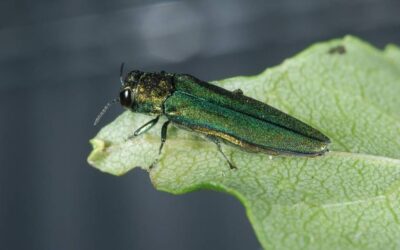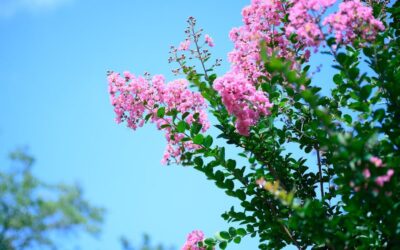Blog Topics
If you notice that something seems to be eating all the leaves off your tree, it’s most likely caused by some kind of leaf-eating caterpillar. Here in northern Virginia, we have three common types of caterpillar that can defoliate trees –
- Fall webworm
- Eastern tent caterpillar
- Spongy moth (f.k.a. gypsy moth) caterpillar
Fall Webworm
Fall Webworm (Hyphantria cunea) is a native Virginia caterpillar that spins webs over a tree’s terminal (branch-end) leaves to make a home and eat the enclosed leaves.
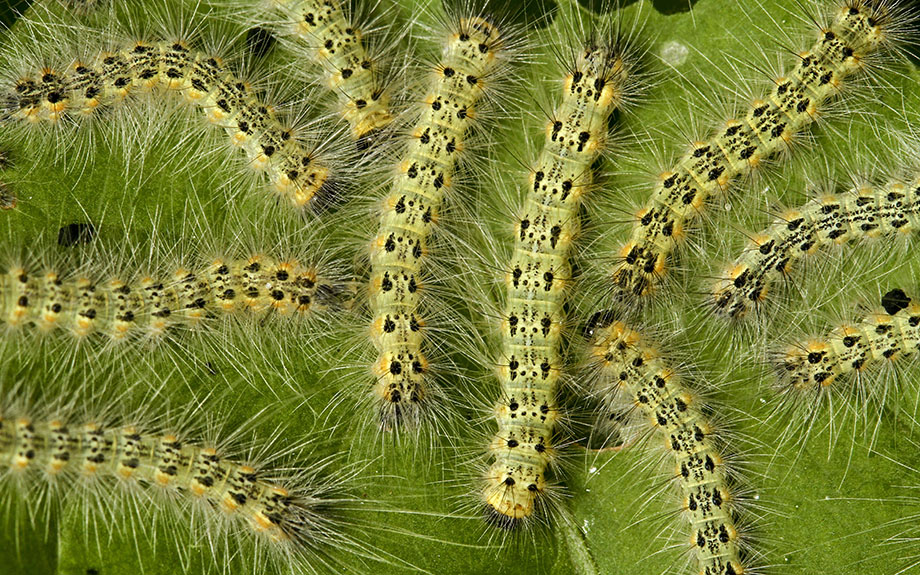
Appearance
The adult moths are white, with dark patches and feathery antennae.
The larvae (caterpillars) are about an inch long and white, yellow or green.
Timing
The female moth lays eggs in spring and early summer on the underside of leaves, and those eggs hatch within two weeks. It’s these newly-hatched caterpillars that damage your trees.
Toward the end of summer, the larvae pupate in the soil and leaf litter around the base of the host tree and overwinter there. In the spring, they emerge as moths.
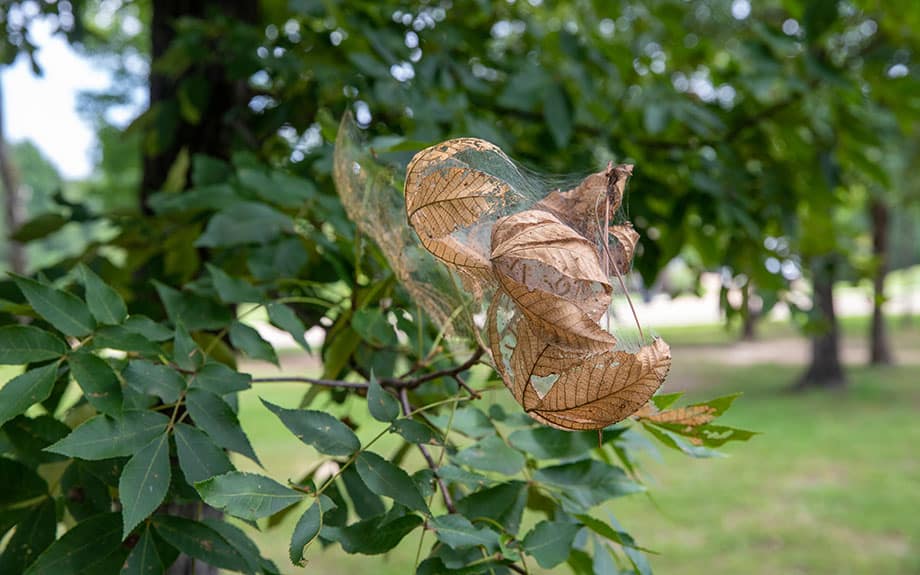
Damage
After hatching in mid or late summer, the caterpillar larvae begin to defoliate trees. The caterpillars spin protective webs on the end of tree branches. As they grow, they enlarge their webs to include more and more leaves. Inside the webs, the larvae eat all but the tough midribs and veins of leaves.
Despite the disfiguring appearance of the webs, webworm is not considered a devastating insect pest in northern Virginia, because:
- Foliar damage is done in late summer
- Affected trees generally recover from defoliation
- Webworm has many predators, including wasps and birds, that help control annual populations
Preferred Trees
Among the webworm’s preferred Virginia tree species are:
- Pecans and hickories (Carya)
- Walnut (Juglans)
- Oaks (Quercus)
- Elm (Ulmus)
- Ash (Fraxinus)
- Apple (Malus)
However, up to 100 tree species are used as hosts by the webworm caterpillars.
Controlling Fall Webworm
Controlling webworm can be done by spraying insecticide on leaves near the expanding perimeter of a web. Spraying the webs directly is not effective, as the spun layers protect the larvae inside.
If the branches of your trees that have webworm infestation are within reach, pruning off and destroying the branches and webs is an effective way to control their populations.
Large trees cannot be effectively sprayed or pruned from ground level, so homeowners should have tree care professionals perform this work.
Eastern Tent Caterpillar
Fall webworm is often confused with the Eastern Tent Caterpillar (Malacosoma americanum) because larvae of both insects build protective webs. However, the insects are different in appearance and habit.
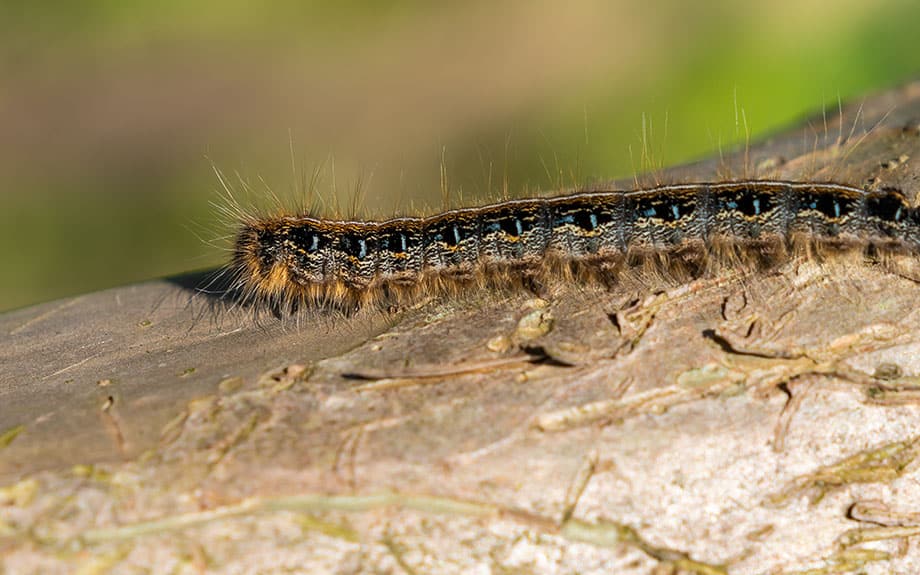
Appearance
Adult tent caterpillar moths are light brown with white stripes and feathery antennae.
The tent caterpillar larvae grow to 2” long or more. They’re dark with yellow tufts and a white stripe running down their back.
Timing
Female moths lay eggs in shiny, dark-brown masses that encircle small branches, where they overwinter.
In spring, the eggs hatch and the caterpillar larvae begin defoliating leaves on the host tree.
After a month or so, the larvae mature and crawl down to the ground to find a sheltered place to make their white cocoons. The pupae develop in a matter of weeks and emerge as adult moths to mate and lay eggs for the following year’s generation.
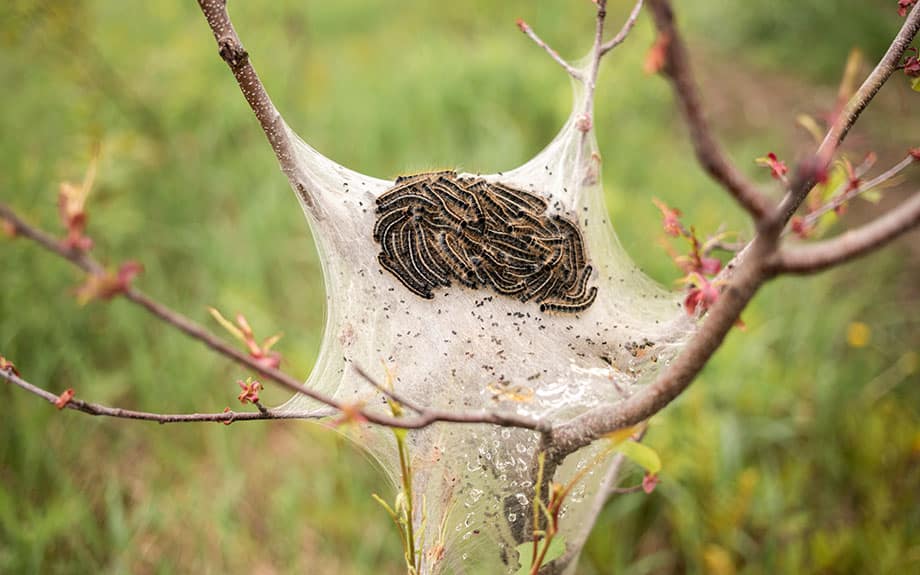
Damage
Eastern tent caterpillars spin dense webs in the forks and crotches of trees, not at the ends of branches as webworms do.
Tent caterpillars emerge during the day to feed on leaves, and return to their communal webs at night.
Controlling Eastern tent caterpillar
The best way to reduce next year’s population is to remove and destroy egg masses in fall and winter.
The pests also have several natural predators, including many bird species, which eat the caterpillar larvae during daylight hours.
If those measures aren’t enough, you can spray caterpillar larvae with pesticides. This should be done as early in spring as possible when the larvae are small. It may be difficult to spray effectively when little foliage has emerged, but direct spraying will kill the larvae. As with fall webworm, spraying the webs will not reach the larvae sheltering inside.
Apply residual, foliar insecticide sprays to leaves and twigs during the day when caterpillars are out eating leaves and reapply it regularly. If you’re spraying fruit trees, only use insecticides designed for fruiting trees.
Do not burn webs! Fire and flames can seriously damage your trees.
Spongy Moth
The Spongy Moth (Lymantria dispar dispar) is a major pest of hardwood trees in northern Virginia, as larvae rapidly defoliate trees.
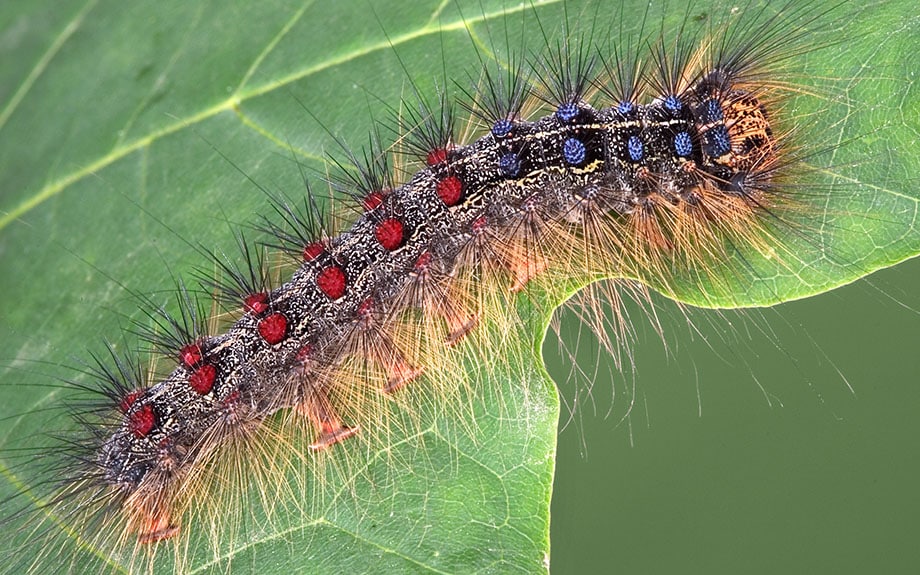
Appearance
The caterpillars are an inch or more in length, black or brown, with spots along their backs and tufts of bristle-like hairs.
Female moths have white wings with black markings, and are flightless. Male moths have darker, brownish wings with black markings, feather-like antennae, and can fly.
Spongy moth egg masses are tan, and covered with wing scales from the adult female moth. The masses hold hundreds of eggs, and can be found on outdoor surfaces of all kinds. Moving items that hold spongy moth eggs is one way the insect is spread, so inspecting all items is vital to prevent the insect’s spread.
Timing
Adult moths in emerge in early summer, after pupating.
The adult moths mate in summer, and female moths lay eggs that will overwinter, hatching the following spring.
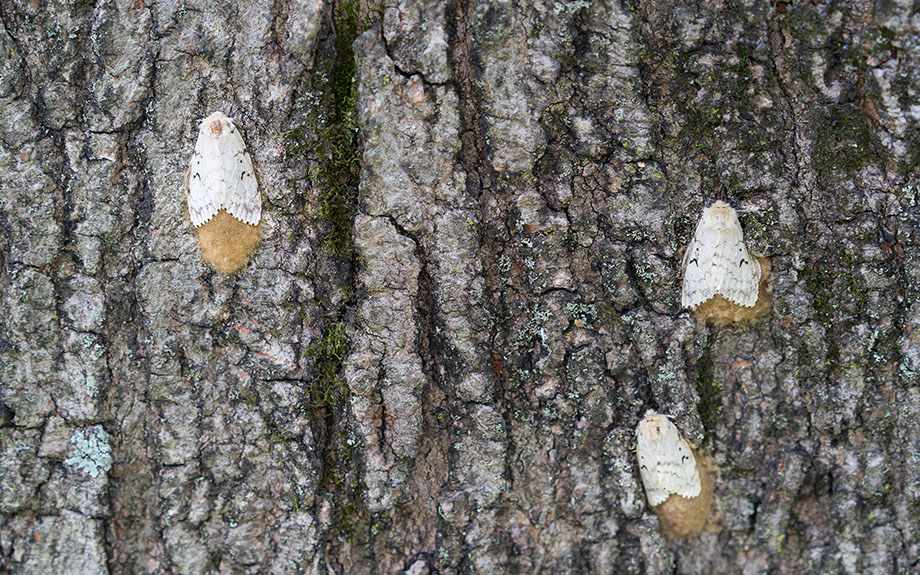
Damage
Spongy moth larvae (caterpillars) hatch in spring, and voraciously defoliate trees as they go through their larval stages. While annual populations of spongy moth fluctuate, severe or repeated defoliation of garden and forest trees can kill large numbers of trees.
Preferred Trees
Its preferred species is oak (Quercus), but spongy moth caterpillars feed on hundreds of tree species, including:
- Apple (Malus)
- Alder (Alnus)
- Aspen (Populus)
- Basswood (Tilia)
- Birch (Betula)
- Boxelder (Acer negundo)
- Larch (Larix)
- American mountain ash (Sorbus)
- Lombardy poplar (Populus)
- Sweetgum (Liquidambar)
- Willow (Salix)
Spongy moth quarantine in Virginia
Loudon and Fairfax counties have been under spongy moth quarantine for some time, as have all but a few Virginia counties. For details, see the Virginia spongy moth quarantine map published by the state’s department of agriculture.
In addition to vehicles, household items, and machinery left outside, firewood is one of the most common ways that insect eggs and larvae are spread. To prevent the spread of destructive insects to forests and wildlands, Virginia state parks forbid campers and visitors from bringing firewood into the parks. Information about firewood quarantines is here.
Controlling spongy moth
Controlling spongy moth is difficult, but homeowners can take the following steps:
- Scrape off egg masses from surfaces and submerge in soapy water for a few days to kill the eggs.
- Spray egg masses with a horticultural oil spray designed for spongy moths.
- Wrap tree trunks with sticky bands to catch larvae as they crawl down tree trunks.
For homeowners, Virginia Tech’s agricultural extension website has information about spongy moth management here.
The most effective control of spongy moth larvae in forests is Entomophaga maimaiga, a fungus that kills spongy moth larvae. Wet spring weather encourages the growth of the fungus, which controls larvae by overwhelming it with fungal spores. When the larvae die, the spores are released and are carried on the wind to other larvae. This fungus, which overwinters in soil, targets only spongy moth larvae.
Give Us a Call at 703-402-9366
If you'd like help with your trees or landscape, have any questions, or would like to schedule an appointment with one of our Certified Arborists, please give us a call. We'd love to hear from you!

